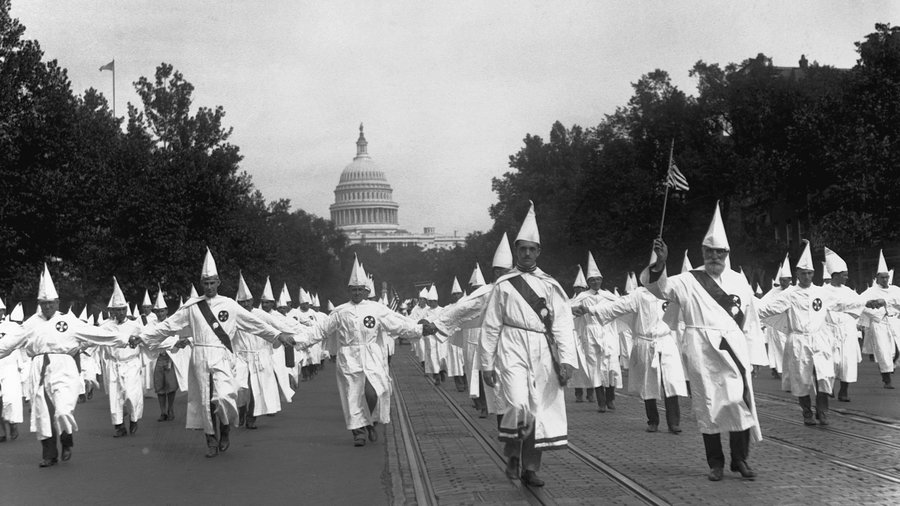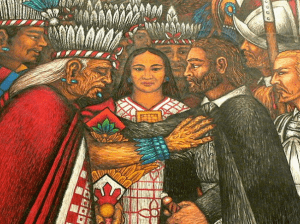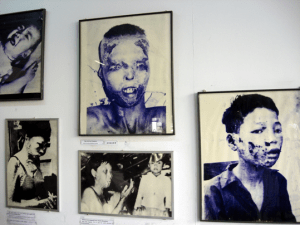Since its origins, the infamous Ku Klux Klan has influenced the attitudes and views of many Americans. The KKK will forever be recognized as the largest political hate group in United States history. Despite the rise and fall of the Klan, it wasn’t until the 1920s that it rose to its highest peak in prominence. During this time period, there was exponential growth in both membership in and support for this notorious cult. The KKK was a growing cult in the 1920s because it instilled religious beliefs, terror, and a skewed view of a better America into the minds of its members through its propaganda of racial superiority.
The original KKK arose during the Reconstruction era of the 1860s and 1870s, and was primarily aimed at restoring the antebellum racial hierarchy to the South. However, it declined in the 1870s due to the passing of legislation aimed at stopping Klansmen’s voter intimidation activities and associated hate crimes. With the end of Reconstruction in 1877, and the passage of Jim Crow laws throughout the South, Klan activity and Klan membership declined. But the cult began a strong resurgence in 1915, with membership skyrocketing to nearly four million by the year 1920.1 This time, the focus of their efforts was aimed at “Americanizing” people by promoting the Constitution, the flag, and the Bible.2 This white supremacist organization lashed out at any group whose ideals conflicted with their own, especially that of African Americans, Catholics, and Jews.

The revival of the Klan was led by its notorious second Grand Wizard (the KKK’s primary leader), William J. Simmons, who was a preacher, a veteran, and an extreme white supremacist.3 He was inspired to reorganize the Klan after watching the silent movie Birth of a Nation, which depicted the Klan as a saving grace, defending the birthright of white southerners and greatly enhancing the public opinion of the cult.4 The religious implications of the KKK stemmed from the teachings of Simmons. Not only were his sermons effective at grasping the hateful minds of Klan members, but he truly convinced them that they were doing the work of God; his credibility led him to a position of power. In fact, one could not join the Klan unless one practiced “militant Christianity,” living in such a way as to be an example to others by following laws, abstaining from drinking, gambling, infidelity, and by not neglecting one’s family. Members were to attend church services regularly, always adhering to the foundations of the Christian faith.5 In addition to this, the KKK burned crosses, often arguing that it was to symbolize the spread of Jesus’ light; it was a symbol aimed to “drive away darkness and gloom.”6 The heavily emphasized morals and negative attitudes toward others are what drove the cult’s frame of thought. Often interpreted in a hateful manner, the religious implications instilled by the KKK’s leaders too often brewed inaccurate thoughts in the minds of its followers; thus, many assumed that the answer to their problem was to commit radical acts of terror.

In addition to their cloaking themselves in the trappings of Christianity, the Klan also used terror tactics to instill fear into both its own members and to those it targeted. The members saw themselves as vigilantes in the restoration of justice—using intimidation, violence, and terror to prevent people of color from attaining any sort of social status or political power. They burned crosses, led beatings, committed assassinations, lynchings, and much more.7 While the symbol of the KKK, the burning cross, held religious connotations for its own members, it was also used as a form of intimidation. They used this symbol of a burning cross to terrorize African Americans.8 In addition to intimidating African Americans, the Klan also targeted Catholics, and had a particularly strong concern with this group due to the fact that they practiced a “different religion” from their own. The motivation for this anti-Catholicism is deeply rooted in American history, going all the way back to colonial times. And with the dramatic increase of Catholics immigrating from Ireland, Italy, and Germany in the nineteenth century, anti-Catholicism was a mainstay throughout American life in the early decades of the twentieth century.9 With the ethnic, social, and racial diversity of American life, tensions continued to heighten among the opposing whites who sought to rid America of these many “outsiders” — a long-held notion in American society. In using both verbal and physical threats, the terror inflicted by the cult caused people to fear the power of the invisible empire that was the KKK.
The idea of creating a better America was yet another reason for the Klan’s rise to prominence in the 1920s. The KKK fought for stricter enforcement of prohibition laws, sought to eliminate political corruption, and wanted to eradicate any form of immigration. Any seemingly “foreign-born” citizen that crossed the path of a klansman was deemed un-American. The Klan assumed they were doing the nation its due diligence in suppressing these “outsiders.” At its peak, the Klan even managed to get political leaders to seek their support and endorsement, since many Americans at this time sympathized with the Klan and its mission.10 And as membership grew, so did their influence. Their opposition to non-whites and to immigration helped to secure the passage of strict quotas on those seeking to come to America.11 The KKK was influential in more ways than one — their power reigning heavily on American society. Even today, white supremacists seek to have their voices heard and their views seen as legitimate. The fight for racial toleration is certainly far from over.

On the other hand, some say that the resurgence of the KKK in the 1920s was due primarily to the effects of industrialization, urbanization, and immigration on society. White Americans became uneasy about immigration and “outsiders” taking American jobs. Many could not stand the idea of “those people” diluting the “racial purity” of American society. But the idea of racial purity is a myth–yet a strong one that many white racists wish to be true. The original soil of America was populated by immigrants and natives alike; whites simply claimed it as their own, as they were to be the guardians of a “city on a hill” and as part of their “manifest destiny” to be the bearers of a supreme culture and society.12 Those that looked to this cult to justify their own beliefs do not parallel with what it means to be an independent individual in American society. The people they were trying to drive out had just as much freedom to be in the United States as they did. Others in support of the Klan also claimed that Simmons was, in fact, preaching for the betterment of society, and that he never resorted to violence to solve problems; though this may seem true, Simmons was actually insinuating his own, twisted version of the word of God, often emphasizing ideas of white supremacy and racial segregation as if that was God’s will. In a pamphlet he wrote in the early nineteenth century, he even states that the primary goal of the organization is to preserve ideals of pure Anglo-Saxon civilization, and many claimed he preached themes of being a pro-American leader by hinting in his sermons that any person in opposition to traditional thought of Anglo supremacy was unwelcome, and simply un-American.13 He silently, yet deviously, instilled discrimination into the Klan’s members. It was even noted that Catholic priests, Protestant ministers, and Jewish rabbis came forward to condemn the organization and its false teachings.14 It seems that the religious implications, terroristic acts, and the skewed ideals used in order to insinuate the making of a better America are contradictory to both the Klan’s mission and the symbols they claimed to uphold.
With a religious basis, the Klan movement emphasized legal and political approaches to solving the “moral crisis” in 1920s America.15 The cult rose to prominence in the 1920s because of their religious, terroristic, and “ideal American” implications; however, their resurgence only served as a detriment. The second coming of the Klan was significant in that it rose to its highest peak in prominence. The KKK’s second coming only continued to fuel the long-held idea of hatred and discrimination that still lingers in the minds of many today.
- Khan Academy, 2016, s.v. “The Reemergence of the KKK,” by Dr. Michelle Getchell. ↵
- David A. Horowitz, Inside the Klavern: The Secret History of a Ku Klux Klan of the 1920s (Carbondale: Southern Illinois University Press, 1999), 10. ↵
- David A. Horowitz, Inside the Klavern: The Secret History of a Ku Klux Klan of the 1920s (Carbondale: Southern Illinois University Press, 1999), 11. ↵
- Roland G. Fryer, “Hatred and Profits: Under the Hood of the Ku Klux Klan,” Quarterly Journal of Economics 127, no. 4 (November 2012): 12. ↵
- Holley Donald, “A Look Behind the Masks: The 1920s Ku Klux Klan in Monticello, Arkansas,” The Arkansas Historical Quarterly no. 2 (2001): 19. ↵
- David Cunningham, “Top 5 Questions About the KKK,” PBS, 2013. Accessed March 12, 2018. http://www.pbs.org/wgbh/americanexperience/features/klansville-faq/. ↵
- Khan Academy, 2016, s.v. “The Reemergence of the KKK,” by Dr. Michelle Getchell. ↵
- PBS, 2013, s.v. “Top 5 Questions About the KKK,” by David Cunningham. ↵
- Mark Paul Richard, Not a Catholic Nation: The Ku Klux Klan Confronts New England in the 1920s (Amherst: University of Massachusetts Press, 2015), 11. ↵
- American Decades, 2001, s.v. “After the Great War: Nativism and the Ku Klux Klan,” by Judith S. Baughman, et.al. ↵
- Gale Encyclopedia of American Law, 2011, s.v. “Ku Klux Klan,” by Donna Batten. ↵
- Khan Academy, 2016, s.v. “The Reemergence of the KKK,” by Dr. Michelle Getchell. ↵
- William J. Simmons, “Pamphlet for the Ku Klux Klan Written by Colonel William Joseph Simmons,” Smithsonian, 2017. Accessed April 6, 2018. https://nmaahc.si.edu/object/nmaahc_2011.155.15. ↵
- Khan Academy, 2016, s.v. “The Reemergence of the KKK,” by Dr. Michelle Getchell. ↵
- Holley Donald, “A Look Behind the Masks: The 1920s Ku Klux Klan in Monticello, Arkansas,” The Arkansas Historical Quarterly no. 2 (2001): 14-15. ↵



122 comments
Nicholas Burch
William J. Simmons was truly an evil person and his reconstruction of the KKK in 1915 was very manipulative. His implementation of “militant Christianity” in his hateful teachings fooled many people into thinking they were doing God’s work. The “Americanizing” propaganda the KKK promoted attracted hateful people across America to become a part of a growing Family where they would be gladly accepted. I’m sure that many of these awful people felt they wouldn’t be accepted anywhere else because of their negative attitudes, so becoming a part of a tight-knit group would make them happy.
Sara Guerrero
No doubt that the KKK was a powerful group in intimidating the individuals that they hated, especially African Americans. It makes me angry that organizations like this still exist today and that their terror had been going on for a long time. I don’t like that they killed people to prove a point and that they government kind of let them get away with it. Also, they use the Bible almost like a reference to their beliefs, but then again there are many interpretations to the Bible. Yet, it’s inhumane the way they treat people they hate and its still instigating fear, but they don’t seem to have such power anymore just because individuals have begun to stand up for their rights and helping each other as a community. Great article and super informative.
Aaron Sandoval
This article was well done and told the story of the Klan very well from its formation to its downfall to its reformation. I remember learning about the reformation of the Klan in a high school history class, and how it was a result of the movie a Birth of a Nation. I was intrigued by the impact media had, and how influential it was in bringing back an otherwise silent organization.
Micheala Whitfield
The KKK is still one of the biggest organizations that affected the United States, as well as, still a controversial topic among literature. I was very interested in finding out they not only targeted African Americans but I was unaware they targeted Catholics. I had always believed it was about a race issue and how white supremacy tried to purify America through the brutal things they did. I can’t imagine the fear everyone had to live with. The KKK did what they intended. To preach their legacy and be remembered throughout history. Even know there are still remnants of the organization.
Seth Roen
Great article, very enlightening, but it is sad saying, such large hate groups were so mainstream back then, of course, they’re still around, a total shadow of their former selves, but still around. I find it ironic how they or their families were in the same positions as those that they are trying to terrify. Hopefully, these hate groups will be a thing of the past.
Pablo Ruiz
The article was very informative and well written. I have always known about the KKK and all their hateful beliefs. I did not know there was a second coming of the Klan in the 1920’s and feel that in some ways there is third coming with the 2016 election. Before our current administration i rarely saw news about the KKK but it seems that its becoming more and more common.
Gabriella Urrutia
The article was very informative and well written. Although I had heard of the KKK before, I didn’t know much about what they believed in. It is hard to understand how they could hurt and treat others differently just because they didn’t have the same beliefs as them. The were racist and targeted people and tried to instill fear into them.
Michael Thompson
I didn’t know that there were really two waves of the KKK. I knew about the first one, which was sparked by the African American slaves being set free. But I didn’t know there was a second coming in the 1920’s. It seems like it still had the same tactics and goals of the first wave, using fear to scare those against them. It seems like a dangerous time to be against what was perceived as an “American”.
Mauro Bustamante
This article was well written and informative about the practices of the KKK, the article shared all the hatred this group of people had and also how they expressed this hatred with terror tactics to instill fear into both its own members and to those it targeted. Their practices against people are harsh and racist they also targeted dark colored people, and Catholics. When reading the article and already knowing a little about the KKK, this group of people are just really selfish and stuck in their old ways and still don’t know how to change their mindset of how society is.
Aaron Peters
This was a well written article, It is a shame that the resurgence of the Klan in the 20th century has set back America’s progress to racial and political equality for years if not decades. I’m surprised how easily they harnessed the dissatisfaction of lower class whites and pushed their agenda of racial impurity being the reason that America was bad. Thankfully they have largely lost their grip on the south.